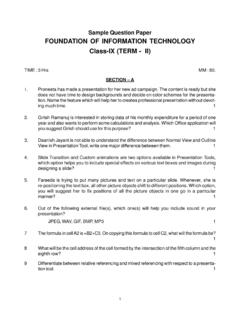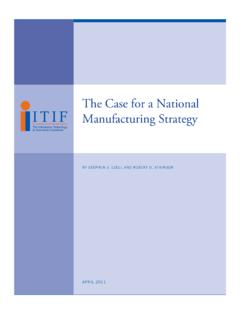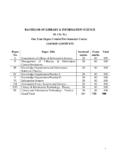Transcription of Research Paper: Information Security Technologies
1 Research paper : Information SecurityTechnologiesbyBenjamin TomhaveNovember 10, 2004 Prepared for:Professor Dave CarothersEMSE 218 The George Washington UniversityThis paper or presentation is my own work. Any assistance I received in its preparation isacknowledged within the paper or presentation, in accordance with academic practice. If Iused data, ideas, words, diagrams, pictures, or other Information from any source, I havecited the sources fully and completely in footnotes and bibliography entries. This includessources which I have quoted or paraphrased. Furthermore, I certify that this paper orpresentation was prepared by me specifically for this class and has not been submitted, inwhole or in part, to any other class in this University or elsewhere, or used for anypurpose other than satisfying the requirements of this class, except that I am allowed tosubmit the paper or presentation to a professional publication, peer reviewed journal, orprofessional conference.
2 In adding my name following the word 'Signature', I intend thatthis certification will have the same authority and authenticity as a document executedwith my hand-written signature. Signature _____Benjamin L. Tomhave_____Benjamin L. Tomhave12/7/2004 1 Research paper : Information SecurityTechnologiesbyBenjamin L. TomhaveAbstractThe following Research paper provides analysis of thirteen (13) Information securitytechnology topics, arranged in ten (10) groups, that are either commonly found oremerging within the Information Security industry. These topics include: Access ControlManagement, Antivirus, Audit Data Reduction, Firewalls, Intrusion Detection Systems(IDS), Intrusion Prevention Systems (IPS), Anomaly Detection Systems (ADS), EventCorrelation Systems (ECS), Network Mapping, Password Cracking, Public KeyInfrastructure, Virtual Private Network, and Vulnerability Scanning Systems.
3 IDS, IPS,ADS and ECS are grouped together under one common heading (Intrusion Detection andAnalysis Systems) due to their commonality and interdependence. This paper providesbasic overview Information about each technology, but primarily focuses on analyzingeach technology within the modern Information Security and business context, looking athow it meets business needs while addressing Confidentiality, Integrity and Availabilityas a Countermeasure that Detects, Corrects and/or L. Tomhave12/7/2004 2 Table of AND OVERVIEW OF CONTROL DATA .. DETECTION AND ANALYSIS Detection Systems (IDS) .. Prevention Systems (IPS).. Correlation Systems (ECS).. Detection Systems (ADS) .. KEY PRIVATE SCANNING L.
4 Tomhave12/7/2004 3 Research paper : Information SecurityTechnologiesbyBenjamin L. AND OVERVIEW OF APPROACHThis Research paper introduces and analyzes ten (10) Information Security of the following sections focuses on a specific technology and adheres to thefollowing general format:oTechnology Overview: A high-level introduction to the Analysis: An evaluation of the usefulness, cost, complexity, and utilityof the technology in the modern business Analysis: The Security technology is weighed against the tenets ofConfidentiality, Integrity and Availability as well as evaluating its role as acountermeasure (detect, correct, protect).The ten Security Technologies addressed in this paper Control Data Detection and Analysis MappingBenjamin L.
5 Tomhave12/7/2004 Key Private Scanning CONTROL MANAGEMENTA ccess control management (ACM) systems pull together identity, authentication andauthorization to restrict what resources a user may access and in what manner that accessmay occur (read, write, execute, modify, etc.). ACM solutions may be based on a numberof Security models, including Discretionary Access Control (DAC), Mandatory AccessControl (MAC), and Role-Based Access Control (RBAC). A standard ACM provides aninterface through which a user will self-identify, followed by a mechanism forchallenging and confirming that identity, and then a method for granting rights, or accessto Information , based on the non-repudiated authentication of the user. Access control isat the heart of Information Security and is the fundamental premise upon which theindustry is based1.
6 Without access control management, there would no method throughwhich to provide Security for systems and AnalysisAccess control management systems provide the foundation for Information securitywithin the business environment. Its usefulness is extensive, with the primary functions1 Ben Rotchke, Access Control Systems & Methodology (New York: , 2004, accessed 06 November 2004); available from ; L. Tomhave12/7/2004 5being to classify data systems according to value and allocate protection mechanisms inaccordance with the value of the resource. According to Tipton and Krause, "[the]essence of access control is that permissions are assigned to individuals or system objects,which are authorized to access specific resources."2 The implementation of ACM systems can range in cost from minor to extreme,depending on the value of the resource being protected.
7 The underlying Security modelapplied also impacts how expensive and complex the solution may be. ACM solutionsare perhaps the most important Security technology that can be deployed, ahead of allother countermeasures, because of its inherent purpose to control access to data andsystems. The utility of the ACM systems, however, is limitless under the assumptionthat a business has resources of value that require Access Control systems are very common and are generally cost-effectivefor most environments. Most operating systems today - ranging from Windows to UNIXto Linux and beyond - make use of a DAC model of access control. Mandatory AccessControl systems tend to be more complex and costly in performance and systems require a much stronger systematic adherence to the precepts of accesscontrol and can thus challenge administrative resources and confound access to data asrequired by the business.
8 Implementation of MAC requires proper foresight and planningto avoid difficulties in the long term; an effort that is often a costly engineering effortfrowned upon by the business. Finally, Role-Based Access Control systems are2 Harold F. Tipton and Micki Krause, <I> Information Security Management Handbook, 4th Edition<I>(Boca Raton: Auerbach, 2000), L. Tomhave12/7/2004 6increasing in popularity and are predicted to saving companies millions of dollars in thecoming AnalysisAn access control management system has the potential for impacting all three tenets ofinformation Security (Confidentiality, Integrity and Availability). The primary role of anACM solution is to protect the confidentiality of a resource by restricting access to theresource.
9 Additionally, an ACM solution will control the attributes of the access, such asread, write and execute. For example, in the case of a data file, an ACM system maygrant a user read access, but deny access to write or modify the data within the a DAC model, access controls are managed directly by the resource owner. In aMAC model, the system dictates what level of access may be granted to a , RBAC assigns access based on the rights of a group (or role) within the users who share a given role have the same access. This approach contrasts to DACwhere each user may have a unique set of rights. MAC is similar to RBAC in terms ofusing a role-based approached based on labeling. However, the inner operations of aMAC vary distinctly from an RBAC; discussion of which exceeds the scope of control management systems hinge on the proper identification of subjects tryingto access objects.
10 The process of positively identifying a subject is called National Institute of Standards and Technology, <I>NIST Planning Report 02-1: Economic ImpactAssessment of NIST s Role-Based Access Control (RBAC) Program<I> (Washington: NIST, 2002,accessed 12 October 2004); available from ; L. Tomhave12/7/2004 7 The authentication process usually occurs when a subject self-identifies and thenresponds to a systematic challenge of the identity. This challenge is based on what youknow, what you have or who you are. A password is an example of something that youmay know, and is currently the most common method of proving identity. A token is anexample of something that you have, and biometrics is an example of who you is a method of identification based on the physical characteristics of a humanbeing, such as a fingerprint, iris scan or retinal scan.






